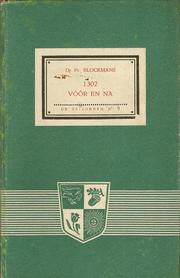
1302 voor en na
By Fr Blockmans
Subjects: Kortrijk, Battle of, Kortrijk, Belgium, 1302, History
Description: “1302 before an after“ (original title in Dutch “1302 voor en na “) by Fr. Blockmans This book is an attempt to put the Guldensporenslag (The Battle of the Spurs) in its historical context. When studying the original documents from that period (chronicles, charters, bills from cities etc…) it is clear that 11 July is not an isolated fact but a link in the chain of events, that started years before and came to their conclusion, albeit temporary, much later . The discrete boundaries of the “before” and “after” are at one end 7 January 1297, the first overt war of Gwij van Dampierre, (Count of Flanders), against his feudal lord Filip IV, king of France and at the other end June 1305 the Flemish - French peace of Athis-sur-Orge , labelled by historians from the romantic period as the “Traité d’iniquité “ or treaty of iniquity. Because these two ‘markers’ are preceded and followed by many turbulent episodes it is crucial first to give an impression of the years 1297 – 1305, an essential period in Flemish history. The events of 1302 should not be viewed from a modern Flemish perspective, the importance should not be underestimated. The destruction of the French feudal troops by West Flemish farmers and craftsmen from Bruges is an historical military fact. However it is also a clash of different worldviews: the larger Flemish cities desire for political independence, while the monarchy aims at centralisation by absorbing peripheral kingdoms; the Flemish workers and commoners hankering for social and economical equality, while the nobility, supported by the French king clings on to its ancient privileges. The impact of this battle reached far beyond the counties borders; the victory of the common men echoed in the cities but more important: although 11 July 1302 wasn’t the end of the Flemish – French fight it secured Flanders from annexation by the south for more than a century. All this means that 1302 should be studied from different angles to gain a more accurate insight. The years 1297 to 1305 can not be calibrated to fit with and support current political tendencies: this period of history is about the life and struggles of the Flemish people in the past and is much more complex. The warriors at Groeningenveld (Groeningen field) were people of their time and the colourful mixture of both army’s reflects my idea: driven here from all sides and with all kinds of motives these people were destined to work together for a brief moment in time after which they scattered again to pursue their own interests and perhaps even meeting again in different constellations to fight each other. So what motives and goals were concentrated in one and the same person or group can only be viewed analytically and in succession. In places where the documentation is scarce or too imperfect to reconstruct the historical event, the visionary force and intuition of the artist is needed to breathe new life into this story.
Comments
You must log in to leave comments.